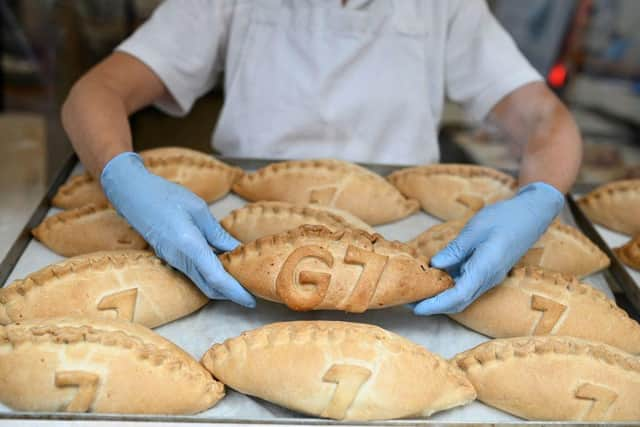What is a Cornish pasty? Region's favourite snack explained as world leaders head to Carbis Bay for G7 Summit
and live on Freeview channel 276
The 2021 G7 Summit is being hosted in the UK, specifically at the Carbis Bay Hotel, near St Ives in Cornwall
The location of the Summit this year offers leaders from around the world the unique opportunity to try out one of the UK’s most famous offerings - the Cornish pasty.
Advertisement
Hide AdAdvertisement
Hide AdThis is everything you need to know about the iconic Cornish pasty.


What is a Cornish pasty?
A pasty is traditionally baked pastry filled with a variety of meat and vegetables. While the modern pasty boasts a range of fillings and flavours, a genuine Cornish pasty must adhere to a strict set of rules.
The Cornish Pasty Association (CPA) explains exactly what makes a genuine Cornish pasty.
Firstly, no meat other than beef can be used in the filling, and no vegetables apart from potato, swede and onion can be used either. Salt and pepper is also permitted.
Advertisement
Hide AdAdvertisement
Hide AdAccording to the CPA, a genuine Cornish pasty must be at least 12.5 per cent beef and 25 per cent vegetable. All the ingredients must be raw when the pasty is assembled, and slowly baked together.
The pastry can be either shortcrust, rough puff or puff pastry, but it has to be savoury and “able to withstand baking and handling without breaking”.
The pasty can be glazed with egg, milk or both to give the finished product a golden colour.
The CPA says that any product sold using the Cornish pasty name “must be produced west of the Tamar, in the wonderful country of Cornwall”.
Advertisement
Hide AdAdvertisement
Hide AdIn 2011, the traditional Cornish pasty was awarded Protected Geographical Indication status in Europe, which gives legal protection to the name Cornish pasty, and stops “inferior products” being passed off as the real deal.
What’s the history of Cornish pasties?
The CPA explains that the pasty has been “a documented part of the British diet since the 14th century”.
Historical evidence shows that some of the first references to the Cornish pasty appeared during the reign of Edward III in the 14th century, with the Oxford English Dictionary suggesting that the pasty was identified in around 1300.
In the 16th and 17th centuries the pasty became more commonplace, where previously it was enjoyed by the rich upper classes and royalty, and by the 18th century it was established as a food eaten by poorer working families in Cornwall.
Advertisement
Hide AdAdvertisement
Hide AdCPA says: “Filling a pastry case with vegetables such as potato, onion and swede was a cheap way to feed a family.
“Meat would have been too extravagant at this time, although a few scraps of cheap meat might have been added now and again.”
The advent of Cornish mining in the 19th century solidified the pasty as a staple in the lives of Cornish families.
Miner's wives would prepare the “all in one meals” for their husbands and children working in the mines. Working at such depth meant that the miners were unable to surface at lunchtime, so the pasties were taken down into the mines.
Advertisement
Hide AdAdvertisement
Hide AdIt is thought that it was the miners that developed the distinctive D shape of the Cornish pasty - the crust became the handle, which was then discarded in order to prevent contaminating the food with their dirty hands.
We want to hear from you: let us know what you think about this story and be part of the debate in our comments section below
What’s the G7 Summit 2021?
The G7 Summit, being held in Carbis Bay, Cornwall, has seen a number of world leaders gather together to discuss key world issues.
The “G7” stands for “Group Seven”, and refers to the seven member countries of the group - the UK, the US, Canada, France, Germany, Italy and Japan.
Advertisement
Hide AdAdvertisement
Hide AdThese are all countries considered to be those with “advanced economies and open societies”.
For this year’s summit, the UK has also invited India, Australia, South Korea and South Africa as guest countries. Representatives from the EU are also in attendance.
The goal of this year’s summit, according to the G7 UK website, is to “help the world fight, and then build back better from coronavirus, and create a greener, more prosperous future”.
Comment Guidelines
National World encourages reader discussion on our stories. User feedback, insights and back-and-forth exchanges add a rich layer of context to reporting. Please review our Community Guidelines before commenting.
